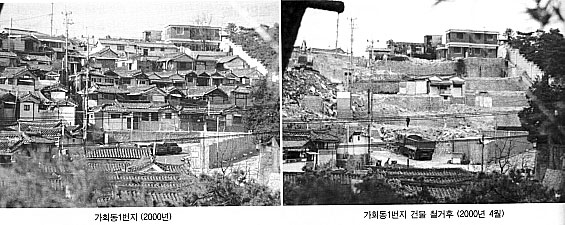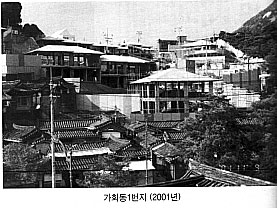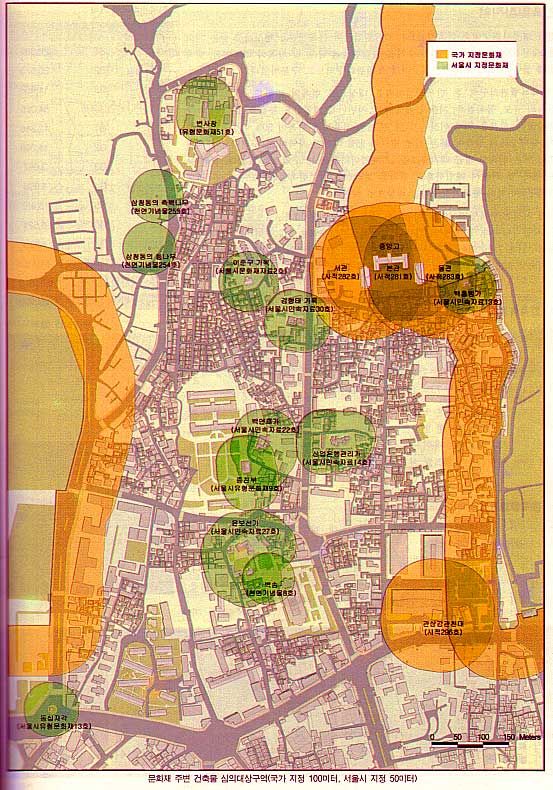The Bukchon Plan
in English - Pages 101-109


You can see the original Korean text of these pages here You can also view an English language interview with David Kilburn about Hanok Preservation here (originally broadcast on KBSWORLD on October 1st 2010)
Problems of Scenery
4. Large Scale Group Development in Bukchon.
Large scale urban development had taken some area such as Kahoi-Dong 1 District which was re-developed under an urban environment development project. Other examples are the construction of the Anguksunwon (Buddhist Temple, 2000t), and Hyundai villas (2001).
When these buildings were built, they replaced groups of small traditional hanoks. Whole stretches of typical Bukchon village scenery were destroyed by these projects.
Kahoi-Dong 1 Environment Development Project
When we looked this project carefully, we could found Kahoi-Dong 1 project had named 1995 under the urban environment development project, however they had changed area indication proclaim 3 times and the urban environment development plan had changed 4 times from the original plan. Since 2000. December they had fixed plan and had been doing the works.
The area is total 9,172.7m2 (2,774.7 Pyung), completion would be 2003. This project had planned like this, the landowner owned land and Chongrogochung is the building developer.
Before this project, Kahoi-Dong 1 had 88 houses including traditional Hanoks and some that had hanok features but were not in fact Hanoks. Most of the buildings 67 houses (76%)were built before 1960’s. Thirteen (15%) were newly built between 1960-1970, and only 8 houses were built after 1970. Anyhow, all of those pre-existing buildings, mostly traditional hanoks, and some new houses were destroyed completely. And then new 2-storey residential houses and commercial buildings have been constructed.
Due to newly permitted buildings are 9 of them. 2 of Multi ownership buildings , 3 individual houses, 1 building would be the commercial purpose, therefore 6 building were permitted by local authority and started the works, at the moment.
Kahoi-Dong 1 used be the scenic view point of Bukchon village, The caste of hanoks of Kahoi-Dong 1 were fairly good looking scenery As the matter of fact, there are not as natural hilly as before, therefore the result of over all scenery would be very different then original Bukchon |
|
Kahoi-Dong 1 in 2000 |
Kahoi-Dong 1 in 2000 |
 |
|
Kahoi-Dong 1 in 2001 |
|
 |
 |
Kahoi-Dong 1 in 1962 |
The redevelopment of Kahoi-Dong 1 in 2001 |
New construction
Anguksunwon (Kahoi-Dong 10-3)
There was one large residential house on this site which was destroyed and replaced with a 4 stories new building called Anguksunwon (a religious facility).
The Anguksunwon occupies 866.00m2 of land and has a floor area of 1,868.05m2. Behind this building still exists the traditional hanok area of Kahoi-dong 11, however you cannot see this from the street due to the adverse effect of the new building.
Kye-dong Hyundai villas
This is a multi-ownership building. Permission for construction was given by the local authority in October 2000 and the building was completed in August 2001. This building used to be Kye-dong 140-10, 140-11, 140-12, 140-12, 140-14. The district was demolished and replaced by 4 storey buildings.
These kinds of group developments created huge problems and had a bad effect on the neighboring traditional hanoks and smaller houses.
 |
|
 |
 |
Pictures and Plans of the Anguksunwon
at Kahoi-dong 10-3 |
|
Scenery maintaining area division.
From our research, we can see that there are four main
types of scenic problem in Bukchon:
Therefore if the area are already
clearly exposed the problems to the public and also problems could be
occurred possibility area etc, each area must have proper systems to
protect the plan.
Next to Cultural Treasure
These areas are must maintaining the scenic problems, If there are not permitted construction buildings around National cultural treasure, these would damage the value of the cultural heritage. Now, Anybody wish to build the building neighboring the National Cultural Treasure should have gotten permissions through the ‘cultural treasure judge association’ by Seoul city Government. The area are indicated so call ‘The protection area of neighboring boarder line of cultural treasure’.
There are many categories of scenery maintaining areas depends on whether the national cultural treasure in this case boundary in 100m this point start from the scenery maintaining area(if it is not in the category of the scenery maintaining area cultural treasure, in this case the point starts the cultural treasure). Or Seoul cultural treasure, in this case boundary in 50m this point start from the scenery maintaining area(if it is not in the category of the scenery maintaining area cultural treasure, in this case the point starts the cultural treasure).
West Side of the Changduk-Gung (Changduk Palace)
Next to cultural treasure area are scenery maintaining area. This situated 100m from Changduk-Gung border line and includea most of the Wonsea-dong area. Most of Wonsea-dong area has already been built up with 4 storied multi-ownership villas which have been completed quite recently. Not expect more than nowadays scenery, however better be aware not to build illegal buildings and must protect and maintaining this area under special care.
We must have a special plan and strategy to protect about the scenery near to the border-lines of Cultural Treasures, such as the Changduk-Gung area. For example, Seoul City Government could buy the properties or institute and enforce very strict constructions laws and regulations for building activities nearby. Otherwise there is risk of critical damage to the value of the Changduk-Gung as a National Heritage.
Cultural Treasures in neighboring areas.
There are 11 National or Seoul Cultural Treasures in Bukchon. National Cultural Treasure in 100m, Seoul Cultural Treasure in 50m in these boundary buildings are strictly prohibited (Next Seoul Cultural Treasure can not built more than 7.5 high building) by angle 27 for 4 sided. However these regulations could protect in this boundary, but not beyond these points. These are not the perfect solutions for protecting the traditional scenery of Bukchon.
The Hanok Areas of Bukchon
An area containing more than 20 hanoks is a protection area. There are two categories of protection areas: ordinary protection areas and special protection areas. Qualification as a special protection area is determined by the quality of the hanoks, the purpose (zoning) of the hanok, the registration of the hanok, whether the hanok is purchased by the Seoul Metropolitan Government, whether the hanok is purchased by a civilian organization, etc. A special protection area has more than 50 hanoks, more than 50% are residential hanoks, less than 25% are hanoks in poor condition, and the average size of a hanok must be more than 177 square meters. This area should receive special protection. An ordinary protection area has more than 20 hanoks, and the average size must be 115 square meters. There are 3 special protection areas in Bukchon, whose total area is 54,000 square meters. There are 7 ordinary protection areas in Bukchon, with a total area of 61,000 square meters. |
|
|||||||||||||||||||||||||||||||||||||||||||||||||||||||||||
Hanok Special Protection Area
The three special protection areas are Kahoi Dong 31 (S1), Kahoi Dong 11 (S2), and Kay Dong Inchon Memorial Area (S3).
The percentage of hanoks (authentic hanoks and nearly authentic hanoks) in each special protection area is 95% in S1, 73% in S2, and 69% in S3. 42% of the hanoks in S1 were in very good condition, 41% were in average condition, and 17% were in poor but livable condition.
In S2, 24% of the hanoks were in very good condition, 52% were in average condition, 22% were in poor but livable condition, and there were fewer hanoks in good condition than in S1.
In S3, 33% of the hanoks were in very good condition, 41% were in average
condition, and 26% were in poor but livable condition.
Hanok Ordinary Protection Area
The ordinary protection areas are Sam Chung Dong, Kay Dong, Anguk Dong, etc., spread all over Bukchon.
In the whole of Bukchon, percentage of hanoks in ordinary protection areas was anywhere from 63% to 100%. The conditions of the hanoks varied as follows: 34%-64% were in very good condition, 20%-35% were in average condition, 20%-56% were in poor but livable condition.

Hanok
Condition |
|||||||||||
|---|---|---|---|---|---|---|---|---|---|---|---|
| Division | Satisfactory | Average | Defective | Not confirmed | Total | ||||||
Building (No) |
Share (%) |
Building (No) |
Share (%) |
Building (No) |
Share (%) |
Building (No) |
Share (%) |
Building (No) |
Share (%) |
||
| Hanok Preservation Area |
S1 Sector | 45 |
42.5 |
43 |
40.5 |
18 |
17.0 |
- |
- |
106 |
100 |
| S2 Sector | 20 |
24.4 |
43 |
52.4 |
18 |
22.0 |
1 |
1.2 |
82 |
100 |
|
| S3 Sector | 9 |
33.3 |
11 |
40.7 |
7 |
26.0 |
- |
27 |
100 |
||
| Sub-Total | 74 |
34.4 |
97 |
45.1 |
43 |
20.0 |
1 |
0.5 |
215 |
100 |
|
| Hanok Preservation Area |
G1 Sector | 21 |
32.2 |
22 |
33.9 |
22 |
33.9 |
- |
65 |
100 |
|
| G2 Sector | 10 |
13.3 |
41 |
54.7 |
21 |
28.0 |
3 |
4.0 |
75 |
100 |
|
| G3 Sector | 7 |
35.0 |
12 |
60.0 |
1 |
5.0 |
- |
- |
20 |
100 |
|
| G4 Sector | 5 |
21.7 |
5 |
21.7 |
13 |
56.6 |
- |
- |
23 |
100 |
|
| G5 Sector | 17 |
30.4 |
24 |
42.9 |
15 |
26.7 |
- |
- |
56 |
100 |
|
| G6 Sector | 6 |
24.0 |
12 |
48.0 |
7 |
28.0 |
- |
- |
25 |
100 |
|
| G7 Sector | 4 |
20.0 |
12 |
60.0 |
4 |
20.0 |
- |
- |
20 |
100 |
|
| Sub-Total | 70 |
24.7 |
128 |
45.1 |
83 |
29.1 |
3 |
1.1 |
284 |
100 |
|
| Other buildings | 117 |
27.5 |
198 |
46.7 |
106 |
24.9 |
4 |
0.9 |
425 |
100 |
|
| Grand Total | 261 |
28.3 |
423 |
45.7 |
232 |
25.1 |
8 |
0.9 |
924 |
100 |
|
Building
Types |
|||||||||
|---|---|---|---|---|---|---|---|---|---|
| Division | Hanoks | Mixed
Type (Hanok + not-Hanok) |
Not Hanoks | Total | |||||
Buildings (No) |
Share (%) |
Buildings (No) |
Share (%) |
Buildings (No) |
Share (%) |
Buildings (No) |
Share (%) |
||
| Hanok Preservation Area |
S1 Sector | 101 |
87.8 |
5 |
4.4 |
9 |
7.8 |
115 |
100 |
| S2 Sector | 80 |
71.4 |
2 |
1.8 |
30 |
26.8 |
112 |
100 |
|
| S3 Sector | 26 |
66.7 |
1 |
2.6 |
12 |
30.7 |
39 |
100 |
|
| Sub Total | 207 |
77.8 |
8 |
3.0 |
51 |
19.2 |
266 |
100 |
|
| Hanok Preservation Area |
G1 Sector | 64 |
77.1 |
1 |
1.2 |
18 |
21.7 |
83 |
100 |
| G2 Sector | 73 |
64.6 |
2 |
1.8 |
38 |
33.6 |
113 |
100 |
|
| G3 Sector | 18 |
90.0 |
2 |
10.0 |
- |
- |
20 |
100 |
|
| G4 Sector | 20 |
71.4 |
3 |
10.7 |
5 |
17.9 |
28 |
100 |
|
| G5 Sector | 48 |
55.2 |
8 |
9.2 |
31 |
35.6 |
87 |
100 |
|
| G6 Sector | 23 |
59.0 |
2 |
5.1 |
14 |
35.9 |
39 |
100 |
|
| G7 Sector | 18 |
58.1 |
2 |
6.5 |
11 |
35.4 |
31 |
100 |
|
| Sub Total | 264 |
65.8 |
20 |
5.0 |
117 |
29.2 |
401 |
100 |
|
| Other | 389 |
28.9 |
36 |
2.7 |
920 |
68.4 |
1,345 |
100 |
|
| Grand Total | 860 |
42.7 |
64 |
3.2 |
1,088 |
54.1 |
2,012 |
100 |
|

Hanok Condition: Dark blue = Good; Pale Blue =: Average; Red = Bad
Possibility of large scale development area
At first, worry some areas are large sized schools, public facility and
large sized places, whether they plan or consider to move to other places,
ever before.
These places are also included the list of scenery maintaining area.
Large buildings that are going to move
The residency for US Embassy staff in Songhyun-dong, and the Sokyuk-dong Korean Army Hospital together with its support . facilities have both decided to move some time in the future, as of 2001.
Samsung Life Insurance company bought paid KRW 100,700 million to buy the 10,800 pyong of the land where American Embassy’s Residency stands on Feb. 25, 2000. Samsung Life Insurance is planning to build a huge Modern Art Gallery. When large scale building are built in Bukchon, they could cause critical damage to the traditional Bukchon Scenery, therefore must make our best efforts to preserve it.
Sokyuk-dong Korean Army Hospital and etc facilities area is 8,260 Pyung.
They have proclaimed to move out to Sungnam Army research area on May.15.2000.
Now, there are many plans and ideas to do in this land. Such as Korean
Tourist Board had decided to build The National Modern Art Gallery using
5,000 Pyung on July 24. 2001. And Army Hospital area, at the moment have
no exact plan what to do, therefore they will decide with related government
body then proclaim to the public later.
The results of all grand size and the types of buildings of Galleries
will definitely give huge impacts of scenery of Bukchon in the future.
Other Big sized lands of Public buildings: 5 of school lands
There are schools on most of the large plots in Bukchon. These are also very worrisome. In other areas, we have seen that when schools move or relocate to other districts, such plots were always used to build modern buildings in large scale developments. Therefore it is necessity to protect these areas in order to retain the scenery of Bukchon.




